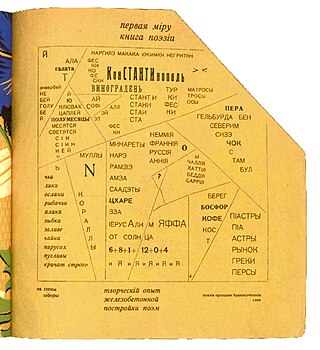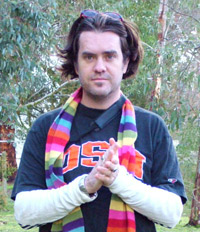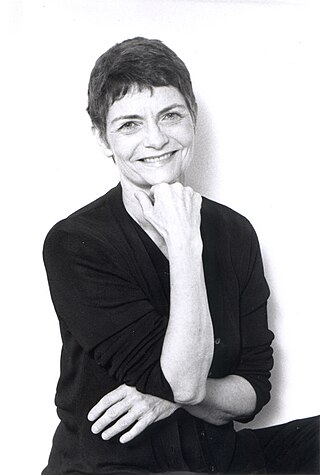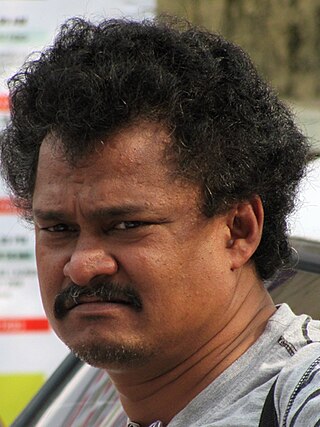Related Research Articles

Digital art refers to any artistic work or practice that uses digital technology as part of the creative or presentation process. It can also refer to computational art that uses and engages with digital media.

Concrete poetry is an arrangement of linguistic elements in which the typographical effect is more important in conveying meaning than verbal significance. It is sometimes referred to as visual poetry, a term that has now developed a distinct meaning of its own. Concrete poetry relates more to the visual than to the verbal arts although there is a considerable overlap in the kind of product to which it refers. Historically, however, concrete poetry has developed from a long tradition of shaped or patterned poems in which the words are arranged in such a way as to depict their subject.
Visual poetry is a style of poetry that incorporates graphic and visual design elements to convey its meaning. This style combines visual art and written expression to create new ways of presenting and interpreting poetry.
Digital poetry is a form of electronic literature, displaying a wide range of approaches to poetry, with a prominent and crucial use of computers. Digital poetry can be available in form of CD-ROM, DVD, as installations in art galleries, in certain cases also recorded as digital video or films, as digital holograms, on the World Wide Web or Internet, and as mobile phone apps.

John Giorno was an American poet and performance artist. He founded the not-for-profit production company Giorno Poetry Systems and organized a number of early multimedia poetry experiments and events. Giorno's creative journey was marked by collaborations, groundbreaking initiatives, and a deep exploration of diverse art forms. He gained prominence through his association with pop art luminary Andy Warhol, sparking a creative partnership that propelled his career to new heights.
Electronic literature or digital literature is a genre of literature where digital capabilities such as interactivity, multimodality or algorithmic text generation are used aesthetically. Works of electronic literature are usually intended to be read on digital devices, such as computers, tablets, and mobile phones. They cannot be easily printed, or cannot be printed at all, because elements crucial to the work cannot be carried over onto a printed version.

Gabriel Rosenstock is an Irish writer who works chiefly in the Irish language. A member of Aosdána, he is poet, playwright, haikuist, tankaist, essayist, and author/translator of over 180 books, mostly in Irish. Born in Kilfinane, County Limerick, he currently resides in Dublin.

Shan shui refers to a style of traditional Chinese painting that involves or depicts scenery or natural landscapes, using a brush and ink rather than more conventional paints. Mountains, rivers and waterfalls are common subjects of shan shui paintings.

Daniel Scott Tysdal is a Canadian poet and film director whose work approaches the lyric mode with an experimental spirit. In June 2007, Tysdal received the ReLit Award for Poetry.
Video poetry is poetry in video form. It is also known as videopoetry, video-visual poetry, poetronica, poetry video, media poetry, or Cin(E)-Poetry depending on the length and content of the video work and the techniques employed in its creation.

Jason Nelson is a digital and hypermedia poet and artist. He is Associate Professor of Digital Culture and a PI at the Center for Digital Narrative at the University of Bergen, where he was also a Fulbright Fellow from 2016-17. Until 2020 he was a lecturer on Cyberstudies, digital writing and creative practice at Griffith University in Queensland, Australia. He is best known for his artistic flash games/essays such as Game, game, game and again game and I made this. You play this. We are Enemies. He has worked on the Australia Council of the Arts Literature Board and the Board of the Electronic Literature Organization based at MIT.

Stephanie Strickland is a poet living in New York City. She has published ten volumes of print poetry and co-authored twelve digital poems. Her files and papers are being collected by the David M. Rubenstein Rare Book And Manuscript Library at Duke University.

Shanshuipoetry or Shanshui shi refers to the movement in poetry, influenced by the shan shui (landscape) painting style, which became known as Shanshui poetry, or "landscape poetry". Sometimes, the poems were designed to be viewed with a particular work of art, others were intended to be "textual art" that evoked an image inside a reader's mind. It is one of the more important Classical Chinese poetry genres. Developing in the third and fourth centuries in China, Shanshui poetry contributed to the process of forming a unique aesthetic outlook.

María Mencía is a Spanish-born media artist and researcher working as a Senior Lecturer at Kingston University in London, United Kingdom. Her artistic work is widely recognized in the field of electronic literature, and her scholarship on digital textuality has been widely published. She holds a Ph.D. in Digital Poetics and Digital Art at the Chelsea College of Arts of the University of the Arts London and studied English Philology at the Complutense University of Madrid.

Anwar Ali, also known Anvar Ali, is an Indian poet and lyricist writing in Malayalam. He is also a literary editor and critic, translator, screenwriter, and documentary filmmaker.
ni_ka is a Japanese poet and new media artist. She gained prominence in the 2010s for inventing new kinds of poetry using digital technology: monitor poetry (monita-shi), designed for computer screens and making use of thousands of emoji, animated GIFs, and other forms of computer graphics, and AR Poetry (AR-shi), made using augmented reality.
Comics poetry or poetry comics is a hybrid creative form that combines aspects of comics and poetry. It draws from the syntax of comics, images, panels, speech balloons, and so on, in order to produce a literary or artistic experience akin to that of traditional poetry.
Poetism was an artistic program in Czechoslovakia which belongs to the avant-garde; it has never spread abroad. It was invented by members of the avant-garde association Devětsil, mainly Vítězslav Nezval and Karel Teige. It is mainly known in the literature form, but it was also intended as a lifestyle. Its poems were apolitical, optimistic, emotional, and proletaristic, describing ordinary, real things and everyday life, dealing mainly with the present time. It uses no punctuation.
Ana María Uribe (1944-2004) was an Argentinian poet known for her work within electronic literature, particularly for visual poetry. According to Jeneen Naji, she was a pioneer in developing digital poetry forms and for "pushing the boundaries of material, form, and visuality in her writing practice."
References
- 1 2 "If DeLillo was an E-Lit Writer: DeLillo'svLanguage as Visual Art in the Digital Age" (PDF).
- ↑ "CHEN Qianxun". chenqianxun.com. Retrieved 2023-11-07.
- ↑ "Renderings: Shan Shui". CURA. 2014-12-03. Retrieved 2023-11-07.
- ↑ "DP-DB : Digital Poetry for Drunken Boat". glia.ca. Retrieved 2023-11-07.
- ↑ "Shan Shui". The NEXT. Retrieved 2023-11-07.
- ↑ Wright, David Thomas Henry (2020-06-16). "Beauty in code – 5 ways digital poetry combines human and computer languages". The Conversation. Retrieved 2023-11-07.